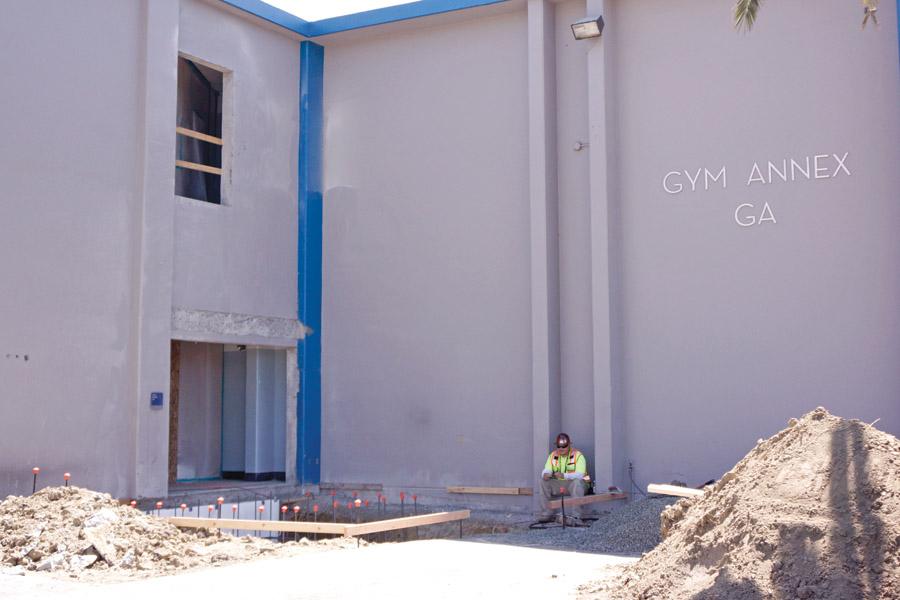Two-story building receives external lift
The 47-year-old Gym Annex Building is undergoing the installation of a lift to give access to students with mobility issues, comply with American with Disabilities Act of 1990, and federal law
A construction workers sits outside the Gym Annex Building on Monday. An external lift is being installed after spending years in planning limbo due to a lack of state funding.
Sep 9, 2014
Access to the north entrance of the Gym Annex Building, adjacent to Comet Stadium, is closed off as construction crews prepare to complete the installation of an external lift by December.
Buildings and Grounds Manager Bruce King said the project, which will help students with mobility issues who are unable to navigate the stairs to reach the second floor, began on July 26 and must be completed before Dec. 25.
Contra Costa Community College District Chief Facilities Planner Ray Pyle said that about a year ago the district hired Critical Solutions (CS), a project and construction management consultant firm, to help manage the various construction projects on campus.
He said the district decided to bring CS on board when it became apparent the GA Building project was stagnated due to a lack of new funding from the state. CS assisted him with securing the $700,000 total construction cost from funds left over from the passing of Measure A in 2006.
After Pyle spoke with on site CS managers, Ron Johnson and John Leary, he said he feels assured that the lift project will be done prior to the December deadline.
King said the development contractor, who won the bid at $500,000, B. Brothers is currently digging out the area where a foundation will be poured to secure the frame that will hold the pre-fabricated lift that is scheduled to arrive on Oct. 1.
Leary said once supporting structure for the pre-fab lift is built and put into place, it would have to undergo three weeks of extensive testing by a Division of the State Architect inspector until it is deemed safe for student use.
“We will not take any shortcuts when it comes to student safety,” he said.
In the meantime, Athletic Director John Wade’s office, in GA-90, is located right next to the construction on the second floor of the building. He, along with coaches, professors and students, has had to get used to taking routes around the construction site since July.
Wade said having only one exit and entrance available, on the south side of the GA Building, has caused confusion among students who are unfamiliar with the building’s layout.
He said while the building has been crowded because of the construction site blocking foot traffic that normally would pass straight through the building, he has not heard any complaints.
Men’s basketball coach Miguel Johnson said getting in and out of the GA Building, so far, has been not been much of an inconvenience. Finding an open parking space during the week, however, has been frustrating.
Johnson said faculty parking has been impacted due to construction workers and large cement trucks having to park near the site on the north side of the building.
“We have to park on the street with the students and finding an open spot has been tough,” he said.
Wade said, “It has been hard dealing with the construction but it is for a great cause.”
Pyle said, over the years, every time a class was held on the second floor and a student with mobility issues signed up for the class, it had to be relocated to comply with the Americans with Disabilities Act of 1990 (ADA).
“It becomes a scheduling problem for the college,” Pyle said. So a modular lift that is easy to install was chosen to remove any access barriers for students with mobility issues, within the smallest time frame possible.
He said the GA lift project will not only bring the structure into compliance with the ADA, but will also bring all three of the multi-story buildings on campus up to code.
ADA code states that a public entity may not deny the benefits of its programs, activities and services to individuals with mobility issues because its facilities are inaccessible. California community colleges and all K-12 schools are public institutions.
Students with mobility issues may still be unable to reach the Physical Science, Biology and Art buildings without transportation assistance from DSPS or police aides because the buildings are terraced onto a hillside without ramps or flat surfaces leading to them.
King said bringing the entire campus up to ADA code would require about $6 million in funding — “much more money than the (district) has to spend.”
Because the GA Building was erected 47-years ago, well before the implementation of the federal ADA law, the immediate installation of a lift was not mandated.
The statute does mandate that the college must work toward completing projects that bring it up to ADA standards or risk having buildings closed.



